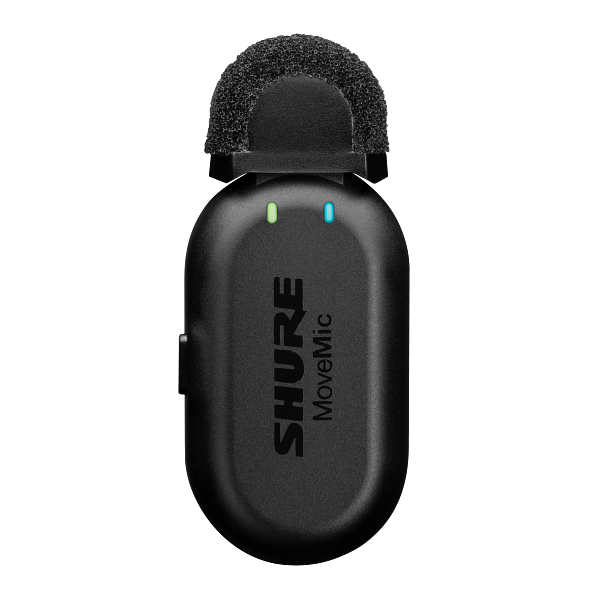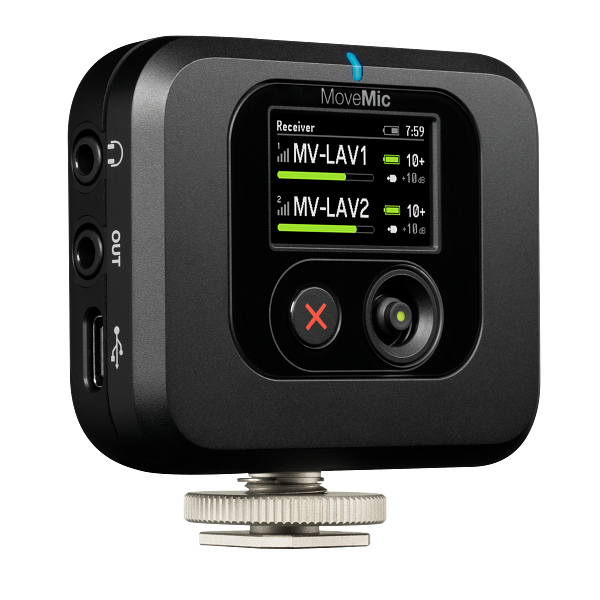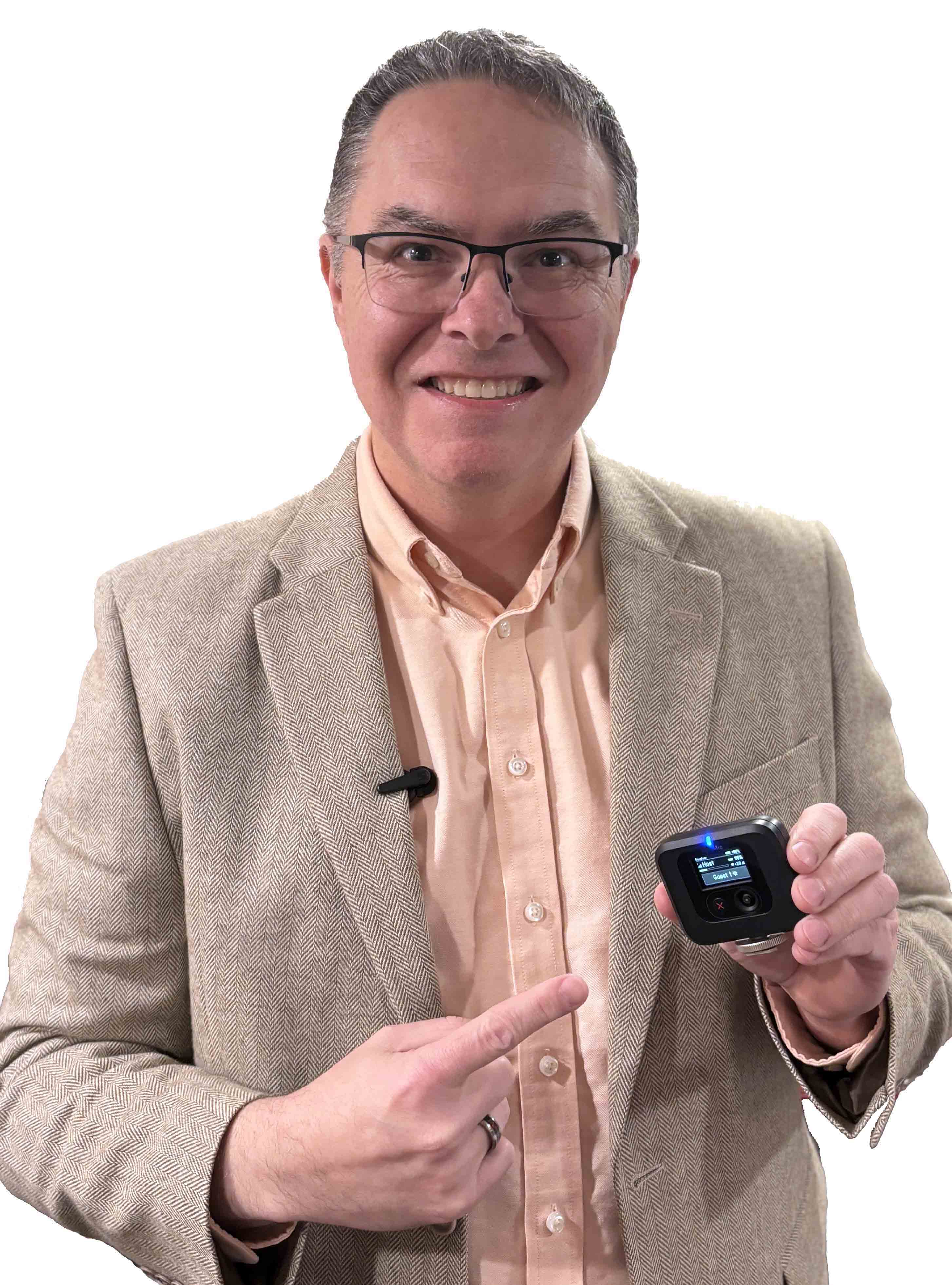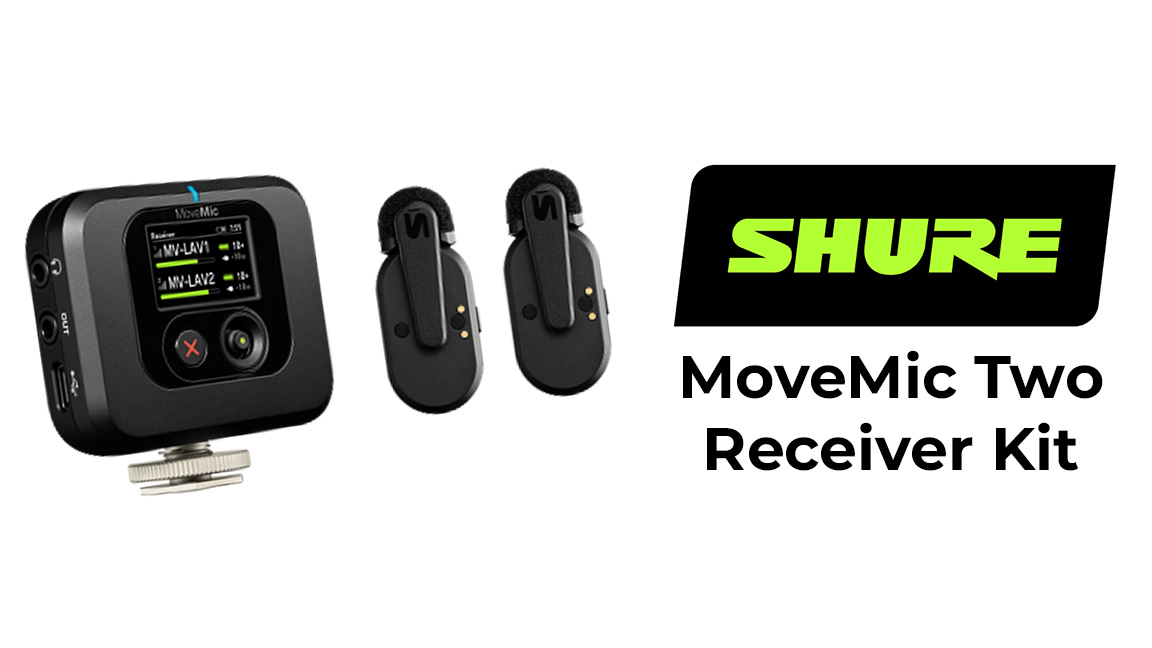So, you want to make corporate videos with your phone, computer, or DSLR, but the on-board mic won't cut it—and you don't want the talent tethered to your gear. Shure has heard your call for help and responded with its MoveMic Two Receiver Kit. Now, your training videos, interviews, and location shoots can feature the audio intelligibility required to share your message.
The MoveMic Two Receiver Kit includes two MoveMic wireless lavalier mics with charging case, the MoveMic receiver, and connecting cables. The wireless mics live in their own charge case, which you charge via a USB-C connection. A small LED outside the case indicates the charge status, and two smaller LEDs indicate the status of the individual mics.
The whole system is stored in a roll bag, which has mesh pockets for the charge case, receiver, and assorted cables and accessories. The roll bag has some light padding that offers some protection, but considering what's inside, it's best to handle with care.
According to Shure, the mics and receiver can run for up to eight hours, while the case can store up to two full charges as well. It takes less than three hours to charge the case or the receiver. Throughout my tests, I never had an issue with power. The system supports PCM/WAV and AAC for Android, as well as PCM/WAV, MP4, AAC, and ALAC for iOS. Both the mics and receiver offer 50Hz-20kHz frequency response, 24-bit audio, and 48kHz sampling rate, with up to 60 dB gain adjustment.
Mic Basics

The flat black MoveMic is about 2 inches long with windscreen. When you attach the mic with the clip facing out, your clothes hide most of the mic body, so it's no more noticeable than any other lav.
I installed the windscreen immediately. Yes, you can remove it, but considering it's made of thin plastic covered with thin foam and snaps in place with more plastic, I'd just set it and forget it. The mic also has an IPX4 rating, so you can record in light rain or snow (no swimming allowed).
Each mic sports one button that handles all the necessary functions—power on/off, mute/unmute, and pairing—and two LEDs use different colors to indicate the various functions. Push the button for a few seconds to turn it on and connect with the receiver. Keep holding it a few seconds more to enter pairing mode.
When the mic is on, one short button press and the mic is muted, while another short press makes the mic live again. Hold the button for a few seconds to shut off the mic. A red LED stays on as long as the mute is active; otherwise, the lights shut off after a few seconds.
It's simple enough to pair one or two MoveMics to Shure's MOTIV Audio app via Bluetooth for audio recordings on your phone. You can also pair with the MOTIV Video app to record videos and even livestream to Facebook or YouTube. That's right, Shure MoveMic offers dual-channel, direct-to-phone functionality. But here's the catch: Without the receiver, you are limited to these two apps—and there's no DSLR connectivity.

Receiver Advantages
About the size of half of a compact cell phone, the MoveMic Receiver offers extensive controls and options. There's a power button on one side, while the other side includes a USB-C port for phone/computer connectivity and charging, 3.5mm audio out for connection to your DSLR, and a 3.5mm headphone jack for live monitoring. It's small enough to fit in a shirt pocket, but there's a built-in cold shoe mount (with a hinge) for easy mounting to your DSLR or camera support system.

The front of the receiver has a small, bright display, as well as a really small, recessed joystick for menu navigation and a red "X" button that lets you back out of various menus. Despite its size, the joystick is surprisingly responsive. The menus allow you to set separate gain levels on each mic, turn noise reduction on or off, switch recording modes (speech, singing, and flat), change the display names of the mics (very helpful), and even shut off the LEDs on the mics (not something I recommend).
Turn on the receiver and it immediately starts looking for mics, and a small LED above the screen will flash blue until it finds one (or two). Once I paired the mics via Bluetooth, it found them easily and consistently.
But there's a quirk: After I paired one of the wireless mics with one of the MOTIV apps on my phone to test it, the mic no longer wanted to play nice with the receiver. That's because the mic stays paired with the app until told otherwise. If you decide to use a mic without the receiver for some quick one-off project, you'll need to go into the receiver's devices menu, find the uncooperative mic, and reconnect it.
You will likely need to install firmware updates at some point. Download the Shure Update Utility app to get the latest firmware for all the components of the system. Installation is pretty simple—and you'll want this software, anyway, to keep all your Shure digital products up to date.
Unfair Testing
As is right and proper, I decided to put the MoveMic Two Receiver Kit in a ridiculous and completely unfair situation to see how well it could perform. And what better place to challenge a wireless microphone system than the middle of the 2024 NAB Show exhibit hall? I interviewed Shure's associate manager of global media relations, Garrison Krotz, at the company's booth in the Central Hall in the Las Vegas Convention Center during the show. I also did not turn on the noise reduction to make sure the test was completely unreasonable.
And yet, it wasn't. I recorded our conversation on my iPhone 15 using the MOTIV Video app. Even with show floor background noise, the interview was clear. Oh, a little noise reduction would have helped, but it was still far better than what you'd get from the mic in your cell phone. And no drops—despite being an area no doubt blanketed with Bluetooth and other wireless activity, I experienced no interference and no lost audio.

I also produced a separate, off-site interview during NAB Show using this system (featuring, ahem, a different company). We were in a hallway outside of a lively reception area, so there was plenty of background noise. Again, I kept the noise reduction off, but I did reduce the background noise a bit in post using Adobe Premiere Rush. I was very pleased with the results.
Of course, I also wanted to test the noise reduction capabilities of the MoveMic Two Receiver Kit, so I shot a stand-up less than 6 feet from my air conditioner's outdoor condenser unit. That's the big piece of equipment that makes the loud rattle-and-hum that is so familiar to those of us who live in South Florida. Shure's noise reduction technology was nothing short of astounding, dropping the noise to a low hum.
Finally, let's talk range. Shure noted the MoveMic components have line-of-sight range of up to 100 feet. I positioned one mic more than 50 feet away in another room. It didn't move and I had no issues. Meanwhile, I took the second microphone outside for a walk. The signal was solid, except when I didn't follow the rules and strayed too far from line of sight. So, while it won't work across a football field, it should be fine across a basketball court, though I'd probably keep it in the paint to be safe.
The MoveMic Two Receiver Kit is priced at $499 on the Shure website. If you're content with only direct-to-phone connectivity, you can save a little cash and buy two MoveMics for $349.
I don’t think I can stress enough how easy this system is to use. Almost everything about it is intuitive. Honestly, I had already paired the mics and started testing them before I even thought about reading the user guide. The audio is excellent, the receiver provides customized control through a simple user interface, and you can carry on an on-screen conversation without running wires or sharing a mic. Time to kick the audio quality of your corporate videos up a notch … or two.

